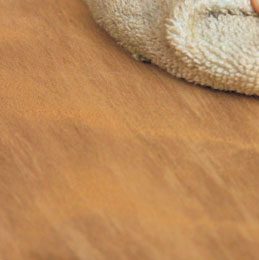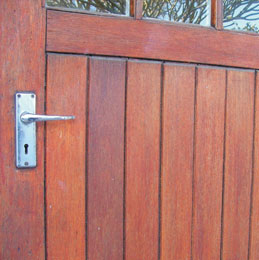How to Points
How to do it
Click on any of the links below to view useful hints and tips
-

New Wood
New wood is usually machine-finished and is almost ready as it is - already smooth and clean.
-

Wood previously sealed with Woodoc - Interior
Interior surfaces start wearing with use.
-

Wood previously sealed with Woodoc - Exterior
Exterior surfaces deteriorate with sun exposure and weather causing the Woodoc coat to eventually biodegrade.
-

Damaged surfaces
Exterior varnish-coated wood (or painted) that has weathered and needs to be removed.
-

Blackened & badly weathered wood
Wood that has been exposed to the elements through lack of a protective coating, poor maintenance or negligance so that the coating has badly deteriorated.
-

Wood must be dry
Always ensure that the wood is completely dry before working with it, otherwise the sealer won't dry properly.
-

Smooth the surface of the wood
When sanding and smoothing wood, it is important to always work with the grain.
- For very rough surfaces, start with very coarse sandpaper and work down to fine grade.
- For wood that just needs smoothing, start with medium sandpaper and work down to Woodoc SteelWool fine grade.
-

Dust the surface
Clean off well with a cloth or clean, dry paint brush and remove all dust. Any dust left on the surface will give the next coat a rough finish.
-

Weathered Woodoc
Woodoc Exterior Sealers biodegrade at the end of their lifecycle. They don't crack or flake.
-

Simply clean down
To prepare a weathered Woodoc finish for refurbishing simply clean it down thoroughly using Woodoc SteelWool and mineral turpentine. As a final preparation clean the surface with a cloth soaked in mineral turpentine to get rid of any dust or loose particles.
-

Woodoc makes the finish look like new again
Resealing the cleaned surface will protect it and bring it back to life.
-

Preparing damaged surfaces for refurbishing
Varnished surfaces left too long before renovation, become brittle and then crack and flake. This leads to peeling and exposure of the wood which in turn results in weathering and blackening. For treatment please refer to the Blackened Wood-section below. If the wood is not weathered or blackened continue with the steps in this section.
-

Remove the old finish
If the old surface coating is loose it can be removed with a scraper followed by coarse sand paper. The scraper should have a straight sharp edge. Always work with the grain. Never force the scraper down on the wood. Use a chemical stripper only if necessary. Follow the instructions on the pack. Once the surface has softened it can be removed with a scraper
-

Smoothing down the wood
The dry and repaired wood must be smoothed down. Use sand paper around a block, starting from a coarse grit working down to fine. Keep the block flat and work with the grain. Woodoc SteelWool works exceptionally well for the final smoothing process. Unclog the sandpaper and Woodoc SteelWool as you go along and clear the dust from the surface.
-

Wood surface ready for sealing
Once the wood is smooth, dust and particle-free and dry, it is ready for sealing.
-

Weather-damaged wood
Wood that is weather damaged and has blackened, can be brought back to life using Woodoc Wood Reviver by following these steps:
-

Remove all metal parts
All metal parts must be removed OR coated with petroleum jelly or grease to avoid damage by Wood Reviver.
-

Prepare the wood for sealing
Follow the procedure for smoothing the wood for sealing under the Damaged Surfaces-section.
-

Wood will look like new
Provided that the surface was not too damaged and the Woodoc Wood Reviver was correctly applied, the wood surface will look like new again once a Woodoc Sealer is applied.
-

Remove all the old surface coating
Follow the steps in the section Damaged Surfaces to remove the old and damaged surface coating.
-

Apply Woodoc Wood Reviver
Once the surface debris has been removed, it can be restored with Woodoc Wood Reviver. Woodoc Wood Reviver has full mixing instructions on the packaging. Follow them and be sure to wear the protective gloves. Scrub the surface thoroughly with the solution.
-

Wash the surface down
Once the Woodoc Wood Reviver has removed all the blackened areas, wash the wood down thoroughly with water. Clean any petroleum jelly or grease protection from the metal parts. Let the wood dry completely. Recommended 2-3 days in warm sunny weather, before proceeding with the next step.
-

Choosing the right sealer
When selecting a Woodoc Sealer, make sure that you use the correct sealer. Indoor Sealers for inside applications. They are hard-wearing and household-damage-resistant. Exterior Sealers for outside applications. They are UV-and weather-resistant. Floor Sealers for all wooden floors. They are hardwearing and flexible
-

Choosing a brush
If the brush is not new, make sure that it is clean, flexible and dry. It is recommended that a good quality, long haired brush is used. Size is important. As a guide use:
- 25 mm for window frames.
- 50 - 75 mm for doors, gates.
- 75 mm or larger for garage doors.
-

Don't overload the brush
An overloaded brush leads to runs & spills. It is not necessary to dip the brush deeper than a third of the bristle length into the Woodoc Sealer. For small and delicate work, even as little as 2 mm is enough.
-

Applying the first coat
Always apply the first coat liberally, touching up spots that become dull within 10 minutes* to achieve an evenly wet surface. *If the wood is dry and porous, keep applying the first coat until the wood remains evenly wet for 10 minutes.
-

Preparing for the second & third coats
It is recommended that three good coats of Woodoc Sealer are applied to achieve the best finish and protection of the wood. Allow the first coat to dry hard and then smooth it down with Woodoc SteelWool. This smoothing down is important to key the surface for the next coat. Clean off the dust and any other loose matter before proceeding.
-

Applying the second & third coats
Apply the second and third coats with long light strokes, coating the surface well with Woodoc Sealer. Keeping the surface evenly wet will give the best results. Smooth the surface down after the second coat, but not the third.
-

Woodoc Wood Reviver
Ideal for cleaning grey or blackened decks, fences and other exterior wood. Can be used on all types of wood .
-

Contents
When sanding and smoothing wood it is important to always work with the grain.
- 1 Sachet Wood Reviver Crystals;
- Wooden Mixing Spatula;
- Protective Latex Gloves;
- Scrubbing Brush
Makes 1 litre of Wood Reviver. Just add warm water.
-

Add the crystals
Use the protective gloves and pour in the crystals.

-

Dissolve
Fill the container with warm tap water and dissolve the crystals.
-

Stir gently
Use the wooden spatula to stir - DO NOT use any metal and avoid contact with hands or skin.

-

Apply with scrubbing brush
Work the solution into the wood with the scrubbing brush. Treat all the wood to ensure an even appearance. Wash down with plenty of water. Repeat process if necessary.
Note: This is not a paint stripper. The wood will be rough after treatment with this product and must be sanded until smooth. When sanding and smoothing wood, it is important to always work with the grain.
Useful application hints
- Always take the brush stroke away from the edge of the wood. Never over it or the edge will "scrape" the brush and cause runs.
- It is far better to use a number of thin, well-laid-on applications than one thick heavy coating.
- Even when working with an Exterior Sealer, always make sure that the area is well-ventilated. Avoid application that will not dry before dewing, mist or rain occurs.
- Always replace the lid tightly on the tin and tap down with a mallet or hammer.
- Storing partially empty tins upside down prolongs the life of the remaining Woodoc Sealer.
Usage precautions
- Please read the instructions on the tin.
- Woodoc sealers are LEAD-FREE and totally safe once applied and dry.
Cleaning your brushes
- Wipe off as much of the remaining Woodoc sealer as you can with a cloth or newspaper.
- Rinse the brush thoroughly in mineral turpentine.
- Shake off any excess mineral turpentine.
- Dry the bristles with newspaper or a cloth.
- Then wash in warm water with dish detergent and rinse thoroughly when finished, straighten the bristles and lay the brush flat or hang it up to dry.






































